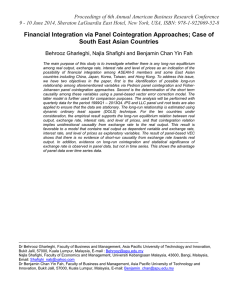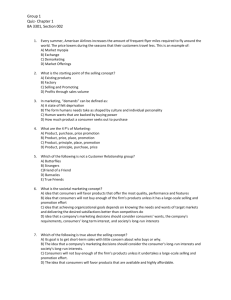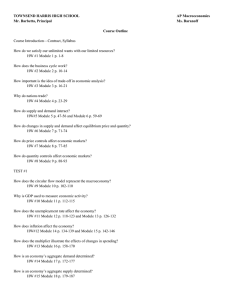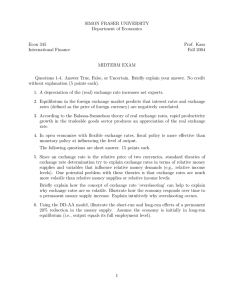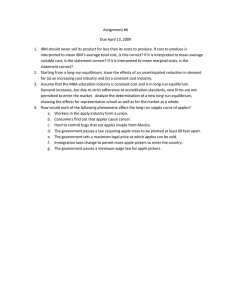Analyzing Factors Affecting U.S. Food Price Inflation by
advertisement
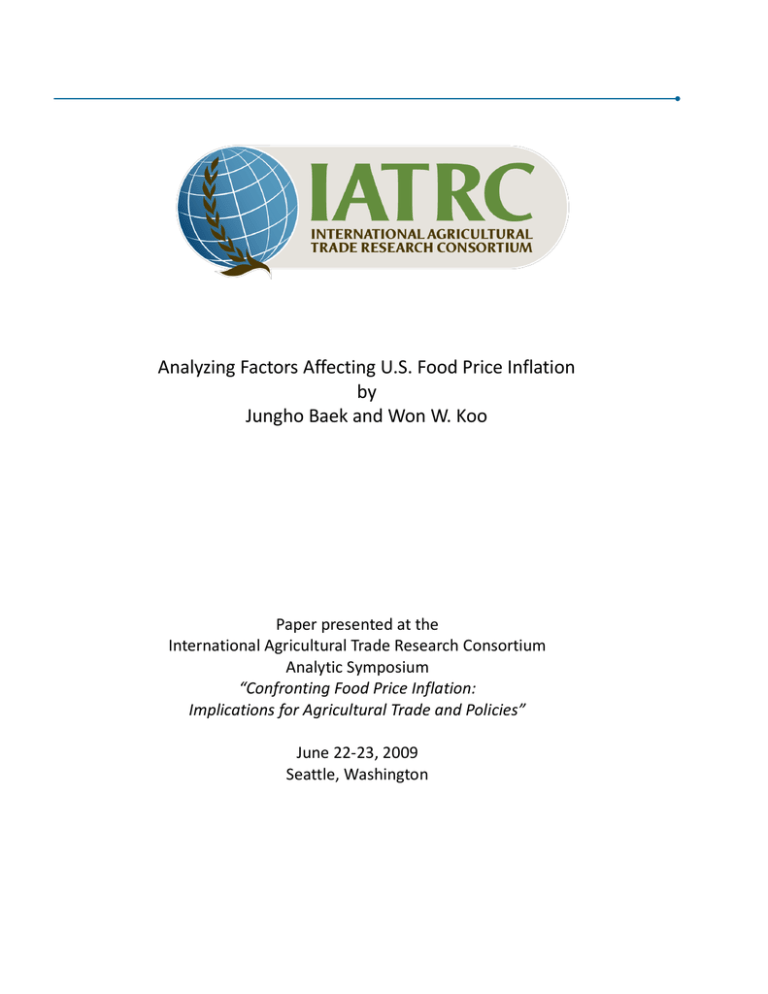
Analyzing Factors Affecting U.S. Food Price Inflation by Jungho Baek and Won W. Koo Paper presented at the International Agricultural Trade Research Consortium Analytic Symposium “Confronting Food Price Inflation: Implications for Agricultural Trade and Policies” June 22-23, 2009 Seattle, Washington Analyzing Factors Affecting U.S. Food Price Inflation Jungho Baek and Won W. Koo Since the summer of 2007, U.S. food price inflation has increased dramatically. Given public anxiety over fast-rising food prices in recent years, this paper attempts to analyze the effects of market factors ─ prices of energy and agricultural commodities and exchange rate ─ on U.S. food prices using a cointegration analysis. Results show that agricultural commodity prices play a key role in determining the short- and long-run movements of U.S. food prices. It is also found that in recent years, energy prices and exchange rate have been significant factors affecting U.S. food prices in both the short- and long-run, implying the strong linkage between energy and agricultural markets. 1 INTRODUCTION U.S. food price inflation has been relatively low and stable over the past 15 years. From 1991 through 2006, the Consumer Price Index for all food (food CPI) has risen by approximately 2.5% annually (Figure 1). Since the summer of 2007, however, this trend changed dramatically as U.S. consumers have begun to face rising food prices at supermarket checkout lines. During the second half of 2007, the food CPI increased by approximately 4.5%, the largest annual jump in 17 years. The U.S. Department of Agriculture (USDA) predicts that the food CPI is to increase 5.5% in 2008. Although the factors driving up the recent food price inflation are complex, higher farm commodity prices and energy prices are considered to be the major culprits behind the rapid spike in U.S. food prices. Specifically, significant growth in the use of farm commodities (i.e., corn) for biofuel production and increased U.S. exports driven by a weaker dollar result in record or near-record prices for key commodities such as corn, soybean and wheat in 2007 (Figure 2). In the 2006/07 marketing year, over 2 billion bushels of corn (20% of the harvested crop) were used to produce ethanol, more than a 30 % increase from the previous year. Corn prices in turn climbed up to $3.40 per bushel in 2007, an approximately 50% increase from the average of the previous 15 years ($2.31). In addition, since corn is competing with soybeans and wheat for cropland, higher corn prices have motivated farmers to increase corn acreage at the expense of soybeans and wheat, contributing to tight supplies and higher prices for those crops. Accordingly, soybean and wheat prices rose from average prices of $5.85 per bushel and $3.38 per bushel during 1991-2006 to $7.74 per bushel and $5.76 per bushel in 2007, respectively. In addition, the U.S. dollar’s global weakness over the past five years has helped make U.S. agricultural commodities more competitive in the world market, thereby boosting demand 2 for U.S. agricultural commodities and hence prices (Figure 3). Between 2007 and May 2008, the value of the U.S. dollar has weakened against its major trading partners such as Canada (12.6%), Mexico (2.4%), Japan (8.4%) and Taiwan (3.6%). The U.S. dollar also has declined against its main trade competitors such as the EU (15.6%), Brazil (22.1%), Argentina (2.0%) and China (5.9%) during the same period. Generally, higher domestic commodity prices tend to decrease commodity exports, but this weak dollar has offset that impact and made U.S. commodity more attractive in the international market. As a result, U.S. corn exports are expected to reach at a record 2.45 billion bushels in the 2007/08 market year. Soybean exports are projected to increase by nearly 40% of the 2007 U.S. soybean crops in the same year, up from 35% the year before. Combining rapidly escalating demand for biofuel production and a weak dollar, therefore, commodity prices are expected to increase substantially in the future. According to the USDA’s projections, the 2008/09 marketing year prices for corn, soybean and wheat will go up to $5.30$6.30 per bushel, $11.00- $12.50 per bushel and $6.75-$8.25 per bushel, respectively. High energy prices have also contributed to the recent drastic surge in U.S. food prices. For example, the price of crude oil was $27 per barrel in December 2003, but it went up to $62 per barrel in April 2006, then on to $98 per barrel in March 2008, and more than $120 per barrel in June 2008 (Figure 4). The rapid increase in crude oil prices has significantly raised the costs of producing and shipping agricultural commodities through increases in the prices of fertilizer, diesel, agricultural chemicals and other inputs. In addition, high crude oil price means high gasoline price, which increases the competitiveness of ethanol, further boosting demand for corn and thus prices (Figure 4). Truckloads of studies have tackled the recent surge in U.S. food prices over the last two years (see Abbott et al. (2008) for detailed overview of these studies). Some studies done by 3 national and international institutions such as the International Food Policy Research Institute (IFPRI), U.S. Department of Agriculture (USDA) and Congressional Research Service (CRS) have typically concentrated on identifying the causes and sources of current food price increases. Other studies financed or produced by interest groups such as the American Coalition for Ethanol (ACE), Grocery Manufacturer’s Association (GMA) and National Corn Growers Association (NCGA) have been mainly conducted to support position of those organizations in the most favorable light possible. For example, the NCGA released two reports, “Understanding the Impact of Higher Corn Prices on Consumer Food Prices” and “U.S. Corn Growers: Producing Food and Fuel,” in 2007, claiming that corn-based ethanol production is not the primary driver of rising food prices. In all these studies, however, their assessments have been conducted on the basis of descriptive statistics and graphical methods that mainly use U.S. crop production and price data. Few studies have relied on an econometric technique in investigating factors affecting fast-rising food prices in the United States. In this paper, therefore, we attempt to examine the effects of market factors on U.S. food prices in a cointegration framework. The empirical focus is on the assessment of the short- and long-run linkages between changes in U.S. food prices and changes in prices of energy and agricultural commodities and exchange rate. For this purpose, we use an autoregressive distributed lag (ARDL) approach to cointegration or an ARDL bound testing approach (referred to here as the ARDL model) developed by Pesaran et al. (2001). Because an error-correction model (ECM) can be derived from the ARDL model through a simple linear transformation, this model is widely used to estimate both the short- and long-run parameters of the model simultaneously. The remaining sections present model, data, empirical results, and conclusions. 4 THE ARDL MODEL The key factors described in the introduction are used to guide the selection of variables for the analysis. Since the focus of this study is the explanation of variations in U.S. food prices ( FPt ), variables that are thought to be of central importance to influence the U.S. food prices are selected for inclusion in the model. These include commodity prices ( CPt ), energy prices ( EPt ), and exchange rate ( ER t ). Hence, the model to be estimated is specified in a log linear form as follows: ln FPt 1 ln CPt 2 ln EPt 3 ln ERt t (1) With respect to the signs of coefficients in equation (1), it is expected that 1 0 and 2 0 , since an increase in U.S. commodity (energy) prices results in an increase in U.S. food prices. As to the effect of exchange rate, the expected sign of 3 is based on the definition of ER t . If ER t is defined in a way that a decrease reflects a real depreciation of the U.S. dollar against major currencies, it is expected to be 3 0 ; that is, the depreciation of the U.S. dollar leads to higher demand for U.S. agricultural commodity exports and thus U.S. prices. Equation (1) represents the long-run relationships among the variables of interest. The purpose of this study is, however, to examine both the short- and long-run relationships between U.S. food prices and its main determinants. In estimating equation (1), therefore, it is necessary to incorporate the short-run dynamics into our estimation procedure. This task can be done by specifying equation (1) in an error-correction modeling format. To that end, following the ARDL approach developed by Pesaran et al. (2001), equation (1) is reformulated as an error-correction modeling format as follows: 5 p p p p k 1 k 1 k 1 k 1 ln FPt k ln FPt k k ln CPt k k ln EPt k k ln ERt k (2) 1 ln FPt 1 2 ln CPt 1 3 ln EPt 1 4 ln ERt 1 t where is the difference operator; p is lag order; and t is assumed serially uncorrelated. Equation (2) is called the error-correction version of the ARDL, because the linear combination of lagged variables (terms with λs ) replaces the lagged error-correction term ( ect 1 ) in a standard error-correction model. Hence, while λs represents the long-run (cointegration) relationship, the coefficients following the summation signs ( ) correspond to the short-run relationship between U.S. food prices and its determinants ( CPt , EPt and ER t ). The first step in estimating equation (2) is to test the existence of a long-run relationship (cointegration) among variables. To that end, the null hypothesis of non-existence of long-run relationship, namely λ 1 λ 2 λ 3 λ 4 0 in equation (2), is tested using an F -test with two asymptotic critical values tabulated by Pesaran et al. (2001) in which a lower value assumes to be purely I (0) , and an upper value assumes to be purely I (1) . If the computed F -statistic is above (below) the upper (lower) critical value, the null hypothesis of no long-run relationship can (cannot) be rejected irrespective of whether the regressors are integrated of the same order (i.e., integrated of order one, or I (1) ), supporting (lack of) cointegration. If the F -statistic falls between the lower and upper critical values, the result is inconclusive. Hence, the main advantage of the ARDL approach is that it does not require the pre-testing of the variables in the model for unit roots unlike standard cointegration methods (e.g., Johansen approach). After determining the existence of the long-run relationship, standard model selection criteria (e.g., Akaike information criterion (AIC) and Schwartz-Bayesian criterion (SBC)) are used to select 6 the optimum lag length of each first differenced variable in equation (2). Finally, the selected ARDL model is used to estimate the long-run coefficients and error-correction model. Since we also employ the Johansen cointegration approach along with the ARDL model in estimating the long-run relationship among the selected variables, we should emphasize the role of Johansen analysis adopted here. Pesaran et al. (2001) show that the robust results for the ARDL model typically rely on the two assumptions of exogeneity of explanatory variables and the existence of a unique long-run relationship among the variables. As such, the ARDL approach adopted here could be valid only if the explanatory variable such as CPt , EPt and ER t are exogenous in the model, and there exists a unique long-run relationship between FPt and the three explanatory variables. The widely used Johansen cointegration approach seems to be particularly well suited in this respect since it tests for the number of cointegrating relationships among a set of variables, as well as to identify the nature of exogeneity by imposing restrictions on a cointegrating vector, which is known as weak exogeneity test. For example, if the number of cointegrating relationships is larger than one, then the ARDL approach fails since it can only estimate one long-run relationship; instead, the Johansen analysis should be used to identify unique cointegrating vectors and interpret them economically. In this study, therefore, the ARDL approach should not be seen as a substitute but as a supplement to the Johansen approach. DATA The U.S. consumer price index for all food (2000=100) is used as a proxy for U.S. food prices and is collected from the Bureau of Labor Statistics (BLS) in the U.S. Department of Labor (USDOL). The prices received index for all farm products (2000=100) is used as a proxy for U.S. commodity prices and is obtained from the Economic Research Service (ERS) in the U.S. 7 Department of Agriculture (USDA). The U.S. index for energy is used as proxy for U.S. energy prices and is taken from the BLS. Finally, the exchange rate is a real effective exchange rate index (2000=100) and is collected from the International Financial Statistics (IFS) published by the International Monetary Fund (IMF). Since the real effective exchange rate is defined as the currencies of trading partners per unit of the U.S. dollar, a decline in exchange rate indicates a real depreciation of the U.S. dollar. Monthly data are collected for the period from January 1989 to January 2008. All variables are in natural logarithms. We emphasize that one shortcoming inherent in using the full sample period (Jan. 1989 to Jan. 2008) is that such series may fail to capture the new relationship among energy prices, agricultural commodities/food prices, and exchange rate (Abbott et al. 2008). In the past, for example, energy and agricultural commodity/food markets have been largely distinct. Recently, however, because of crop-based biofuels, the prices of energy (i.e., crude oil) and commodities (i.e., corn) are much more linked and tend to track each other closely. Besides the full sample period (case І), therefore, we also consider a sub-period that covers recent nine years (Jan. 1999 to Jan. 2008) to test the maintained hypothesis that U.S. food prices and its major determinants are much more closely linked in recent years (case II). EMPIRICAL RESULTS Unit Root Tests Before proceeding with the ARDL bound test, the presence of a unit root of the four variables ( FPt , CPt , EPt and ER t ) is tested for the following reasons: (1) to ensure that, although the ARDL is applicable irrespective of whether the variables are I (0) or I (1) , none of the variables is I (2) or beyond because the computed F -statistics are not valid in the presence of I (2) variables; 8 and (2) to determine whether the Johansen analysis can be used to test for the number of cointegrating relationships among the variables because it requires the variables to be nonstationary. To that end, we conduct unit root tests using the Dickey-Fuller generalized least squares (DF-GLS) test (Elliot et al. 1996). This test optimizes the power of the conventional augmented Dickey-Fuller (ADF) test by detrending. The DF-GLS test works well in small samples and has substantially improved power when an unknown mean or trend is present (Elliot et al. 1996). The results show that in both case І and case II, the levels of all the series are nonstationary, while the first differences are stationary, indicating that the six variables are nonstationary and integrated of order one, or I (1) (Table 1). Before estimating the ARDL, therefore, the Johansen method can be applied to test the number of cointegrating relationships among the four variables in both models. The DF-GLS test statistics are estimated from a model that includes a constant and a trend variable. The Schwert Criterion (SC) is used to determine lag lengths for the unit root tests. Johansen Cointegration Test The Johansen cointegration procedure is applied to determine the number of cointegrating relationships among the four variables using cases І and II. The results show that, with both cases І and II, the trace tests reject the hypothesis of no cointegrating vector ( r 0 ) at the 10% level, but fail to reject the null of at most one cointegrating vector ( r 1 ) (Table 2). This result indicates the presence of a unique long-run relationship among FPt , CPt , EPt and ER t . The Johansen tests in both cases are based on the VAR models with three lags, which are selected by both the Hannan-Quinn and Schwarz criteria. Tests for residual serial correlation, heteroskedasticity and normality show no signs of serious misspecification in both cases. The 9 VAR model includes an unrestricted constant, a linear trend, and deterministic seasonal dummy variables in the two cases. Having obtained one cointegrating vector in both cases І and II, the test for the long-run weak exogeneity is conducted to examine whether any of the variables can be treated as exogenous in a cointegrating vector (Table 3). This test is implemented by restricting a parameter in speed-of-adjustment to zero ( i 0 ). The results show that, with both cases, the null hypothesis of weak exogeneity cannot be rejected for commodity price, energy price and exchange rate at the 5% significance level, indicating that these three variables are weakly exogenous to the long-run relationship in the model. The finding suggests that commodity price, energy price and exchange rate are driving variables in the system and significantly affect the long-run movements of food price, but are not influenced by food price. In other words, such variables as commodity price ( CPt ), energy price ( EPt ), and exchange rate ( ER t ) can be treated as the explanatory variables in the model. In sum, the Johansen procedure shows that commodity price, energy price and exchange rate are exogenous in the model and there exists a unique long-run relationship between U.S. food prices and the explanatory variables in both cases І and II; therefore, the ARDL model specified in equation (2) can be pursued on them. ARDL Bound Tests for Cointegration The first step in applying the ARDL procedure starts with determination of the lag order ( p ) in equation (2). To this end, we use the Akaike information criterion (AIC) and Lagrange multiplier (LM) statistics for testing the hypothesis of no serial correlation (Table 4). With the selected lag orders, we then test the existence of a long-run relationship (cointegration) among variables. For 10 this purpose, the null hypothesis of non-existence of long-run relationship, namely λ 1 λ 2 λ 3 λ 4 0 in equation (2), is tested using an F -test with the critical value tabulated by Pesaran et al. (2001). The results show that the calculated F -statistics are 8.14 in case І and 4.32 in case II and lie outside the upper critical value 3.77 at the 10% level. As a result, the null hypothesis of no cointegration can be rejected, indicating the existence of a stable long-run relationship among food price, commodity price, energy price and exchange rate. This also confirms the findings obtained from the Johansen procedure. Having found the existence of the long-run relationship, the selected ARDL model is used to estimate the long-run coefficients and error-correction model. Specifically, the long-run model is estimated from the reduced-form solution of equation (2), in which the first-differenced variables jointly equal zero. The error-correction model is estimated by the ARDL approach. To that end, a general-specific modeling approach guided by the AIC is used to select the optimal lag structure of the ARDL specification. The results of the long-run coefficient estimates from the ARDL model show that, with case І, the coefficient of commodity price are statistically significant at the 5% significance level (Table 5). Specifically, the U.S. food price has a positive long-run relationship with commodity price. This implies that an increase in commodity price causes a rise in U.S. food price in the long-run. However, it is found that energy price and exchange rate are not statistically significant even at the 10% significance level, indicating that these two variables have little long-run effect on the U.S. food price in the full sample period (Jan. 1989-Jan. 2008). With case II, on the other hand, all three variables are found to be statistically significant at least at the 10% significance level. Specifically, the U.S. food price has a positive long-run relationship with energy price. This indicates that an increase in energy price leads to a rise in food price through the increased 11 costs of producing and shipping agricultural commodities. In addition, the U.S. food price has a negative long-run relationship with exchange rate. This suggests that the depreciation of the U.S. dollar indeed make U.S. agricultural commodities more competitive in the world market, thereby boosting demand for U.S. agricultural commodities and hence prices. Notice that a comparison of results between case І and case II shows that the link between U.S. food price and its major determinants such as prices of energy and commodities and exchange rate has been quite strong in recent years. The error-correction model is estimated by the ARDL approach to capture the short-run dynamics that seem to exist between the U.S. food price and its main determinants (Table 6). The results show that, with case І, as seen in the long-run results, commodity price is the only factor affecting U.S. food price in the short-run. With case II, on the other hand, U.S. food price has a positive short-run relationship with commodity price and has a negative short-run relationship with exchange rate. Unlike the long-run results, however, energy price is found to have little effect on food price in the short-run. In addition, the coefficients of the error-correction terms ( ect 1 ) are found to be negative and statistically significant at the 5% significance level for both cases, ensuring the existence of the long-run relationship among variables (Table 6). Note that Kremers et al. (1992) and Banerjee et al. (1998) show that a highly significant error-correction term is further proof of the existence of stable long-run relationship. The coefficients of ect 1 in both cases are -0.14~-0.21, implying that deviation from the long-run equilibrium is corrected by 14~21% in one month. Finally, the diagnostic tests on the short-run models as a system indicate no serious problems with serial correlation, heteroskedasticity, and functional form specification. 12 CONCLUDING REMARKS While many studies have used descriptive methods to investigate factors that affect the recent surge in U.S. food prices, relatively little attention has been paid to the empirical analysis of this issue. In this paper, therefore, we attempt to examine the short- and long-run effects of changes in market factors such as prices of energy and agricultural commodities and exchange rate on changes in U.S. food prices. For this purpose, the ARDL approach to cointegration is used to estimate monthly price data from 1989 to 2008. The results show that agricultural commodity prices play a key role in affecting the short- and long-run behavior of U.S. food prices. We also find that energy prices and exchange rate have been significant factors influencing U.S. food prices in recent years in both the short- and long-run. This further suggests that the linkage between energy and agricultural commodity/food markets has been recently quite strong, due mainly to crop-based biofuel production. 13 4.9% 4.5% 3.4% 2.5% 1991-2006 2007 (Jan.-Jun) 2007 (July-Dec.) Figure 1. Consumer Price Index for all food (food CPI) in the United States 14 2008 (Jan.-Jun) 9 8 Dollar per bushel 7 6 Soybean 5 4 Wheat 3 2 Corn 1 0 1991 1993 1995 1997 1999 Figure 2. U.S. Agricultural commodity prices, 1991-2007 15 2001 2003 2005 2007 Canada Mexico Japan Taiwan Brazil EU China Argentina -2.0% -2.4% -3.6% -5.9% -8.4% -12.6% -15.6% -22.1% Figure 3. The weakness of the U.S. dollar for its major trading partners, Jan. 2007- May 2008 16 140 450 400 120 350 300 80 250 Gasoline 200 60 150 40 100 Crude Oil 20 50 Jan-08 Jul-07 Jan-07 Jul-06 Jan-06 Jul-05 Jan-05 Jul-04 Jan-04 Jul-03 Jan-03 Jul-02 Jan-02 Jul-01 Jan-01 Jul-00 0 Jan-00 0 Figure 4. Crude oil and gasoline prices in the United States, Jan. 2000-May 2008 17 Cents per galon Dollar per barrel 100 Table 1. Results of DF-GLS unit root tests Case І (1989:1-2008:1) DF-GLS statistic Lag Case П (1999:1-2008:1) DF-GLS statistic Lag ln FPt -2.08 2 -1.53 1 ln CPt -1.36 1 -2.45 1 ln EPt -1.60 2 -2.42 2 ln ERt -1.68 1 -0.99 1 ΔlnFPt -13.08** 1 -8.71** 1 ΔlnCPt -8.75** 1 -6.87** 1 ΔlnEPt -10.18** 1 -7.52** 1 ΔlnER t -9.55** 1 -6.58** 1 Note: FPt , CPt , EPt and ER t represent U.S. food price, U.S. commodity price, U.S. energy price and exchange rate, respectively. ** denotes rejection of the null hypothesis of a unit root at the 5% level. The 5% and 10% critical values for the DF-GLS tests in Case І are -2.89 and -2.57, respectively. The 5% and 10% critical values for the DF-GLS tests in Case П are -3.02 and -2.73, respectively. denotes the first difference of the variables. The lag order for the DF-GLS is chosen by the Schwert criterion (SC). 18 Table 2. Results of Johansen cointegration rank tests Case І (1989:1-2008:1) Null hypothesis Eigenvalue Trace statistics H0: r = 0 0.1232 62.08 [0.07]* H0: r 1 0.0864 32.38 [0.37] H0: r 2 0.0315 11.95 [0.81] H0: r 3 0.0207 4.73 [0.64] Case П (1999:1-2008:1) Null hypothesis Eigenvalue Trace statistics H0: r = 0 0.2251 47.23 [0.05]** H0: r 1 0.0927 20.20 [0.42] H0: r 2 0.0625 9.05 [0.29] H0: r 3 0.0283 3.04 [0.11] Note: ** and * denote rejection of the null hypothesis at the 5% and 10% significance levels, respectively. p -values are given in parentheses. 19 Table 3. Results of weak exogeneity tests Case І (1989:1-2008:1) Weak exogeneity Variable H0 :i 0 FPt 7.40 [0.00]** CPt 0.72 [0.39] EPt 0.14 [0.71] ER t 1.53 [0.22] Case П (1999:1-2008:1) Weak exogeneity Variable H0 :i 0 FPt 6.74 [0.00]** CPt 2.48 [0.12] EPt 1.52 [0.22] ER t 0.29 [0.59] Notes: FPt , CPt , EPt and ER t represent U.S. food price, U.S. commodity price, U.S. energy price and exchange rate, respectively. i represents the speed of adjustment to equilibrium. LR test statistic is based on the 2 distribution and parentheses are p -values. ** denotes the rejection of the null hypothesis at the 5% significance level. 20 Table 4. Results of ARDL bound tests for cointegration Case І (1989:1-2008:1) Case П (1999:1-2008:1) 3 3 2 SC (3) 0.42 0.66 F -statistic 8.14 4.32 Cointegration Cointegration AIC Lags Decision 2 Note: A lag order is selected based on Akaike information criterion (AIC). SC (3) is LM statistics for testing no serial correlation against lag order 3. F -statistic for 10% critical value bounds is (2.72, 3.77), which is taken from Table CI in Pesaran et al. (2001). 21 Table 5. Estimated long-run coefficients using the ARDL bound tests Case І (1989:1-2008:1) Case П (1999:1-2008:1) 0.37 0.23 CPt (3.23)** (7.10)** 0.12 0.20 EPt (0.80) (2.80)** -0.05 -0.09 ER t (-0.64) (-1.79)* Constant 4.16 2.26 (10.1)** (7.29)** Note: CPt , EPt and ER t represent U.S. commodity price, U.S. energy price and exchange rate, respectively.** and * denote significance at the 5% and 10% levels, respectively. t values are given in parentheses. 22 Table 6. Estimated short-run coefficients using the ARDL bound tests Case І Case П (1989:1-2008:1) (1999:1-2008:1) -0.30 -0.39 FPt 1 (-4.57)** (-4.10)** 0.03 0.02 CPt (1.61)* (1.44) 0.04 0.04 CPt 1 (2.60)** (2.17)** Coefficient EP -0.02 -0.01 t estimates (-1.14) (-1.04) -0.01 -0.06 ERt (-0.24) (-1.74)* 0.01 -0.01 Constant (9.00)** (7.40)** -0.14 -0.21 ect 1 (-3.57)** (-2.65)** 0.68 0.81 Serial correlation [0.64] [0.58] Diagnostic 1.14 0.85 Heteroskedasticity tests [0.34] [0.55] 1.25 0.01 RESET [0.26] [0.96] Note: ** and * denote significance at the 5% and 10% levels, respectively. Parentheses are t statistics. Brackets in diagnostic tests are p -values. 23 REFERENCES Abbott, P.C., C. Hurt, and W.E. Tyner. 2008. What’s driving food prices? Farm Foundation, Oak Brook, Illinois. Banerjee, A., J.J. Dolado, and R. Mestre. 1998. Error-correction mechanism tests for cointegration in a single-equation framework.” Journal of Time Series Analysis 19: 267284. Capehart, T., and J. Richardson. 2008. Food price inflation: causes and impacts. Congressional Research Service, Washington, DC. Elliott, G., T.J. Rothenberg, and J.H. Stock. 1996. Efficient tests for an autoregressive unit root. Econometrica 64: 813-836. Johansen, J. 1995. Likelihood-based inference in cointegrated vector autoregressive models. Oxford: Oxford University Press. Kremers, J.J.M., N.R. Ericson, and J.J. Dolado. 1992. The power of cointegration tests. Oxford Bulletin of Economics and Statistics 54: 325-348. National Corn Growers Association. 2007. U.S. corn growers: producing food and fuel. Chesterfield, Missouri. National Corn Growers Association. 2007. Understanding the impact of higher corn prices on consumer food prices. Chesterfield, Missouri. Pesaran, M.H., Y. Shin, and R.J. Smith. 2001. Bounds testing approaches to the analysis of level relationships. Journal of Applied Econometrics 16: 289-326. Schnepf, R. 2008. High agricultural commodity prices: what are the issues? Congressional Research Service, Washington, DC. 24
